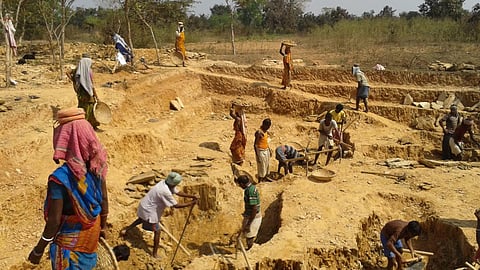
- Topics
- Feature
- Opportunities & Events
- Data
- Hindi Portal
- Topics
- Feature
- Opportunities & Events
- Data
- Hindi Portal

Amulya Soren couldn’t get stable yields in the kharif (monsoon) paddy in his farm. A member of the Santhal tribe, he was the beneficiary of a surplus land redistribution programme in Hirbandh block of Bankura, West Bengal. The undulating terrain in which his farm lies receives sufficient rainfall of about 1000 mm a year, yet sufficient irrigation was an issue. This was because the runoff in the area is rapid and soil moisture content is low.
Amulya's plight was typical of the thousands of adivasi farmers in the area. Suitable groundwater aquifers were not available in the area to tap into. The people had scant means at their disposal to withstand the dry spells during the monsoon season and were all faced with instability in crop production as a result. As resilient as the nature around them, Amulya and his wife did not want to give up. Like most people, they used to grow paddy during the monsoons from mid-June to mid-September after which the fields were left crop-free.
PRADAN, an NGO which works predominantly in remote tribal communities in eastern and Central India, tried to address this problem through an intervention. Since the area is marked by low per capita land holdings, the thrust was on enabling people to take two to three crops from their small holdings, and to solve the problem of water for crops, PRADAN started promoting small ponds locally known as happa.
Happas are generally 60 feet long, 40 feet wide and 12 feet deep and are constructed in lands that are at a slight elevation. To build these small, deep ponds meant that farmers in Bankura had to give up some of their land. While many had reservations about this, Amulya was one of the first to show interest in developing the system to harvest rainwater.
These landscape-based systems were initially designed to cover 5 percent of the land (hence known as the 5 percent model) to provide supplementary irrigation to kharif paddy. This was followed by providing life saving irrigation to the rabi (winter) crop.
Farmers began to make amendments to the original design and the ponds became deeper. Seeing the results from Amulya’s farm other farmers started adopting this simple but labour-intensive technology. The adoption rate of this technology was significant in scheduled castes- and tribes- dominated villages.
Now, the crop mix in Amulya’s farm is more diversified with paddy, maize, mustard and vegetables. The happa is being put to multiple uses including domestic purposes, livestock and fish rearing, which has also improved the nutrition status of his household. More agricultural labor employment is being generated (to excavate farm ponds) for small farmer households like Amluya’s. The earth excavated from the happa is being used to level lands. Fallow lands are increasingly being cultivated and the landless are taking lands on lease.
First, PRADAN had to focus on the institutional development processes in the area. It was “guided by two general themes: expanding livelihood opportunities for the rural poor and utilising the talents of capable and caring people in implementing such projects in the grassroots” (1). "Initial contacts were made with women of the households and Self Help Groups formed as thrift and credit associations", says Prosenjit Mondal, who coordinates PRADAN’s work on happas at Bankura.
Through these groups, livelihoods were promoted in a diverse range of sectoral activities related to rainfed agriculture based on the resources, skills, and risk perception of the households. PRADAN supported and assisted the Self Help Groups to leverage finances from the government for this. It also helped them establish collaborative linkages with banks in order to leverage credit. Training was provided to build people’s skills and capabilities.
To boost happa construction by locals, PRADAN focused on liasioning with officials in the area to leverage finances from the Mahatma Gandhi National Rural Employment Guarantee Scheme (MGNREGS). PRADAN helped the households chart out concrete short-term and medium term plans and estimate needs for technical and financial assistance.
According to a study by the International Water Management Institute (IWMI) (2), the average annual incomes increased by Rs. 5,792 as a result of irrigation through happa in the area. The study estimates that the benefit-cost ratio of happa is 3.03 and the internal rate of return on the cash flow calculated over 15 years is 24.8 per cent. Water lifting technologies like pumps (either owned or through pump rental markets) are being promoted in the area so farmers can make best use of the happas.
The study concludes that “if rolled out across the state, happa could benefit up to 626,000 households irrigating 14 percent of the total land area. The investment cost to reach this number of people could be up to USD 2,940 million. Investment in happa can be supported by local governments, especially through MGNREGS.” (2)
The happas helped save the paddy crop and enabled people to grow crops in winter, something that they were not doing previously. "The impacts are considerable and the government needs to invest in these systems to tackle water woes", Amulya says.
Is the government listening?
(1) PRADAN website
(2) Evans, A. E. V.; Giordano, M.; Clayton, T. (Eds.). 2012. Investing in agricultural water management to benefit smallholder farmers in West Bengal, India. AgWater Solutions Project country synthesis report. Colombo, Sri Lanka: International Water Management Institute (IWMI). 28p. (IWMI Working Paper 148). doi: 10.5337/2012.210
(3) The case study has been produced as a part of a joint documentation effort by the Revitalizing Rainfed Area (RRA) network and India Water Portal to capture significant achievements and learning from the convergence process at RRA’s comprehensive pilot projects.